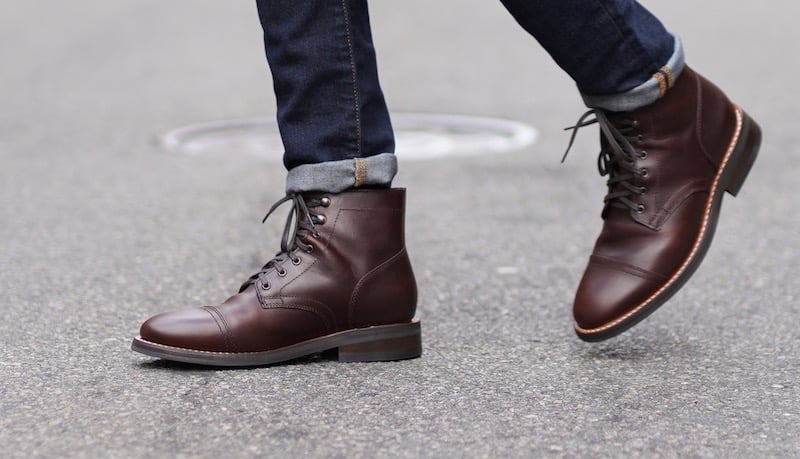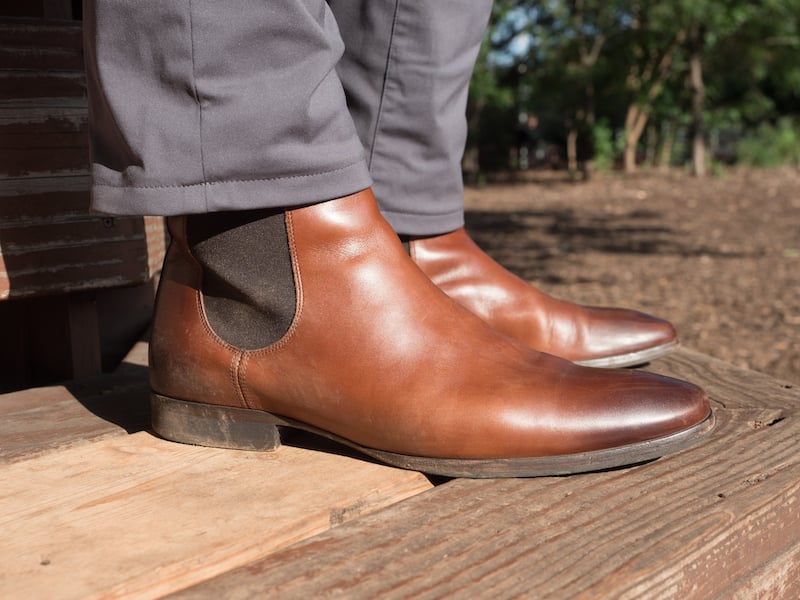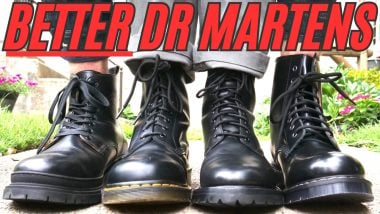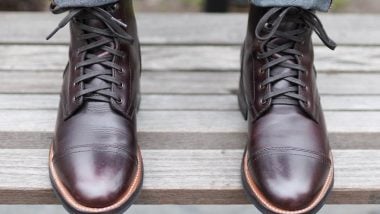What Is EVA Foam and Why Is It Being Put In Boots?
Have you noticed that a lot of newer boot companies are moving away from your traditional cork-and-leather construction and are using more novel materials? Thursday Boot Co has DuraEVA strips in the midsole. Wolf & Shepherd use HDEVA in their heels. Oliver Cabell makes use of Vibram’s Morflex outsole, not to mention materials like Texon and polyurethane, once known for being used in sneakers, are often found in modern midsoles.
Why do you need anything else other than leather, rubber, and cork in your boots? The short answer is comfort, but there’s more to consider when you make your next boot purchase.
So, can you have comfort, durability and a traditional look in the same boot?

What is EVA?
EVA is a foam commonly used in the midsoles of sneakers that provides great shock absorption when you walk or run. While “comfort” is (of course) a subjective term, it’s often considered more comfortable than traditional midsole and outsole materials like cork, leather, and rubber.
Basically, it’s the squishy stuff in the midsole of your running shoes. In the 1970s, Nike was first to popularize ethylene-vinyl acetate (EVA) foam, and it may not seem like a big deal, but adding more cushion to the midsole of a running shoe radically changed the look and feel of footwear. (As an aside, Nike founder Phil Knight’s memoir Shoe Dog is a must read.)
While you typically find EVA in active footwear, it’s increasingly found in dress shoes and boots. For example, Wolf & Shepherd use EVA extensively in their products and they even sponsored a runner to complete a half-marathon while wearing their Honey Cap Toe dress shoe.
[Related: My review of Wolf & Shepherd’s running boot]

[Related: My list of The Best Leather Briefcases for Men]
Why Use EVA to Make Boots?
EVA works well as a shock absorber in midsoles. It’s why Crocs exist and have a reputation as comfortable footwear: they are pure EVA.
If you go to a store and try on a pair of heritage boots made from traditional materials and then you try on a pair of boots with EVA, the EVA boots will be more comfortable out-of-the-box. That’s not to say heritage boots aren’t comfy, rather that it takes a longer time for a traditional midsole and insole to conform to the shape of your foot — though Red Wings never absorb shock as well as EVA-based boots.
The other reason manufacturers add EVA to dress shoes is product differentiation. Using novel materials like EVA sets a company apart from the pack and hey, it allows for PR-friendly headlines like “23-Year-Old Sets Fastest Half Marathon Record… In Dress Shoes.”
EVA vs Traditional Materials
Traditional materials for making soles and midsoles, such as cork, rubber and leather, also provide shock absorption. However, these materials have limitations. Cork, for example, will compress after repeated use and once it compresses, it stays compressed. It still absorbs some shock, but is much more rigid.
Leather outsoles, while soft relative to some rubbers, wears out relatively quickly and doesn’t provide much in terms of shock absorption.
Many forms of rubber also act as a shock absorbers — when bodyweight is applied it contracts like a spring, and when weight is removed it expands. However, rubber is still relatively stiff, so it doesn’t provide a ton of absorption.
EVA has special physical characteristics. It’s not so squishy that it loses its shape, but it’s squishy enough to absorb a lot of shock. So EVA is sometimes considered a ”goldilocks” material; It offers more shock absorption than rubber and regains its shape better than cork while offering ample cushion.

EVA vs Polyurethane vs Texon
The biggest difference between EVA and polyurethane is that polyurethane breakdowns down regardless of use. The technical term for this is “hydrolysis.” You will lose the shock absorbing qualities of polyurethane while your boots are stored in the closet. In fact, polyurethane will literally crumble after a time, even if you never wear them.
Texon is a proprietary materials company that makes structural components for footwear, often from compressed cellulose. (That’s the main substance found in plant cell walls.) It’s as durable and comfortable as most other modern midsole materials. As Scott Gabrielson from Oliver Cabell told us, Texon is actually used in a vast number of Blake stitched shoes these days, which includes boots. He added,
EVA is a great, highly durable material that stands the test of time. This is why many boot makers are using it. You can still have a boot that will last 10-15 years with an EVA sole. This isn’t true with many of the other material options.”
[Related: Goodyear welt vs Blake Stitch, which is best?]

So, How Durable Is EVA?
EVA does have a reputation for lacking durability.
In running shoes and hiking boots, the EVA midsole is often the first component to wear out. After a certain number of miles, the EVA compresses and loses its ability to absorb shock.
The footwear industry measures durability of midsoles with “compression set,” which is basically the percentage of a midsole that springs back after it’s worn. Rubber has a very low compression set because it springs back to near its original height and doesn’t compress much to begin with. Low quality EVA has a high compression set and doesn’t spring back very much. Higher quality EVA, like the one used by Thursday, keeps its shape and can last until the boot needs a resole.
Still, all materials wear out eventually. One benefit of a high quality pair of boots is that we can rebuild them as the individual components wear out. However, this may not be true for all boots constructed with an EVA midsole.
Examples of EVA in Boots
It’s not always easy to tell if a shoe or boot contains EVA. There are a lot of proprietary names and EVA usage varies from a thick outsole to a thin midsole or footbed. We got in touch with a few brands to learn more about the EVA they use in their boots.
[Related: My list of The Best Boots for Men]
Thursday Boot Co: DuraEVA
Thursday Boot Co adds EVA to dress shoes and boots, and this company created their own proprietary EVA called DuraEVA. They incorporate a strip of EVA that’s hidden, so the boots maintain a traditional look.
The company’s co-founder, Connor Wilson, told us,
We wanted something that can be abused just like a boot, but with a ride that feels more like a sneaker.
And they spent a lot of time and energy researching a perfect blend of EVA, even spending additional time getting the color right so it would blend seamlessly into the general aesthetic.
“If you’re talking about resoleable boots that you can wear for years at a time, you want to make sure the EVA lasts at least as long as the outsoles do,” Wilson says. “DuraEVA is a higher-durability version of EVA that will often outlive the wear on vulcanized rubber outsoles. DuraEVA is formulated to last significantly longer than traditional EVA, which means that you won’t need to replace it until it’s time for a resole anyway.”

Oliver Cabell: Vibram’s Morflex
Oliver Cabell uses EVA in the outsole of some of their SB 3 boots (above) and moc toes, but it’s a blend of materials: Vibram mixes EVA with rubber to make their Morflex outsoles. According to Vibram, Morflex is an expanded EVA rubber compound that offers shock absorption and durability.
“We wanted our moc boot styles to bring something truly unique, so we focused our energy on comfort and weight,” Gabrielson, Oliver Cabell’s founder tells us.
Wolf & Shepherd
Wolf & Shepherd were also early adopters of EVA in their products. This isn’t surprising as their cofounder, Justin Schneider, worked at Adidas and was a track-and-field athlete.
Their strategy is to remove “the wood and nails found in classic dress shoes and replace them with compressed High Density-EVA cushioning found in premium running shoes.”
That’s the kind of EVA they use; what they call HD EVA, which they also claim is more durable than your standard sneaker foam.
Wrapping Up
You can’t paint all EVA with the same brush because there are so many proprietary manufacturers and custom components available. It’s possible to get stuck with a low quality EVA that will wear out quickly. However, most reputable brands know of this problem and take care to source high-quality, durable EVA from trusted manufactures. It’s comfortable, lightweight, well priced, and doesn’t need a tough break in like a lot of more classic, heritage-style soles.
Aesthetically, you can find EVA in very traditional looking footwear like Thursday’s Captain boots and modern looking casual wear like Oliver Cabell’s Mocs. So whatever your style, there’s a pair of comfortable boots with EVA.
Compared to other common components in boots, EVA is a great compromise between comfort and durability. If you’re looking for an everyday affordable boot, that’s comfortable out-of-box, EVA is definitely worth trying out.
Featured image via Wolf & Shepherd











Great article!! Thanks.
But where is the EVA in Thursday boots? I’ve seen cutting videos and you can see that the midsole is leather, so is the EVA in place of the cork filling?
The leather is on top of the foam, it’s like a leather topped footbed.